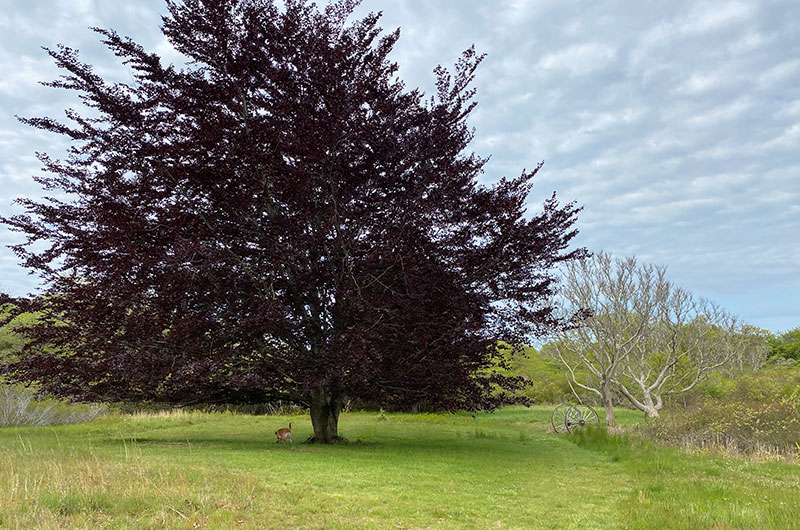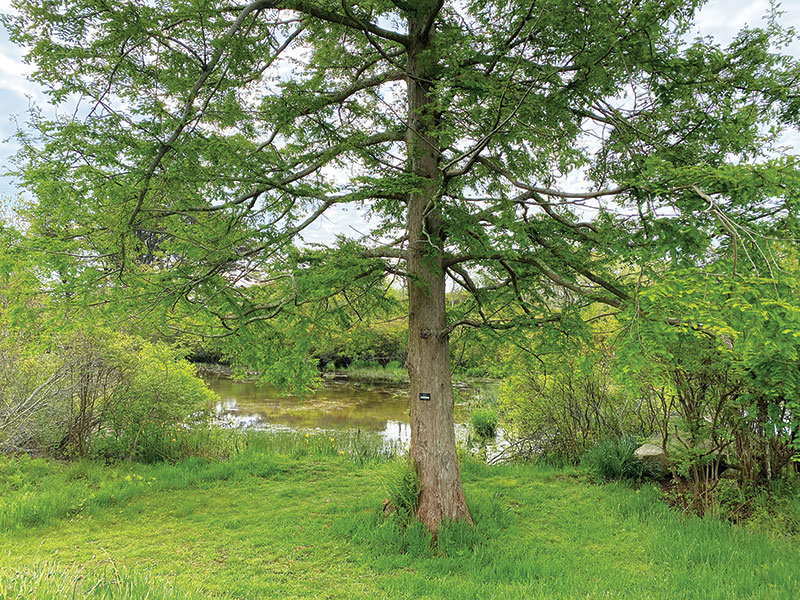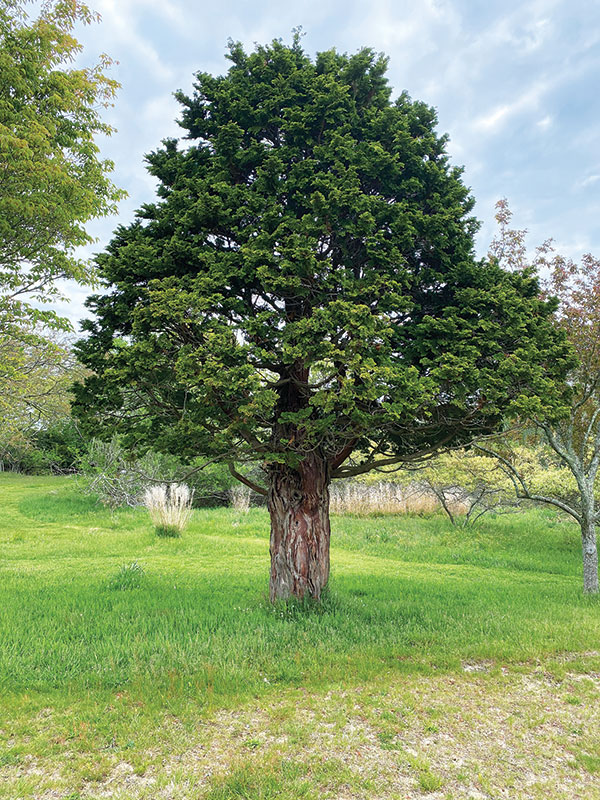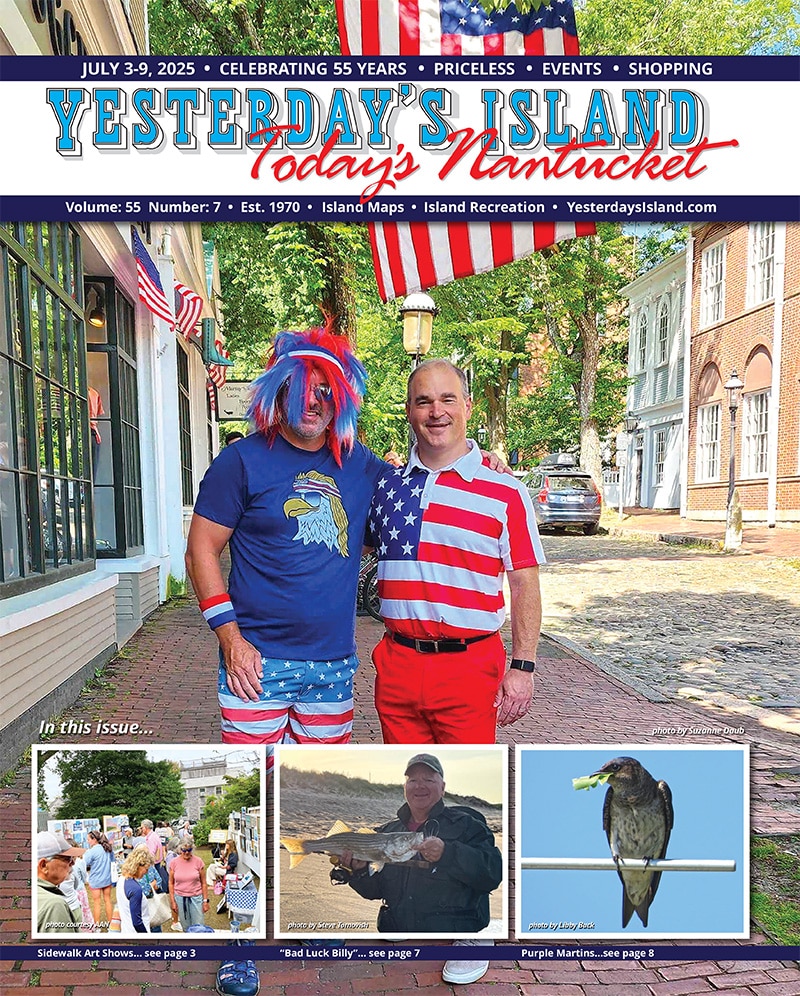by Dr. Sarah Treanor Bois
Director of Research & Education at the Linda Loring Nature Foundation
You may have noticed, driving up Polpis Road or riding along the bike path towards ‘Sconset, a unique red pergola along the road flanked on either side by two stone lions. Once marking the entry to a private yard and secret garden, now these sentinels are welcoming spirits to a newly restored island oasis.
In 2017, the Nantucket Land Bank (NLB) acquired what was the Reyes property at 219 and 231 Polpis Rd. The NLB has worked to restore the property and create a park on the almost 16-acre parcel. The property, now officially known as Reyes Pond, consists of roughly an acre of upland encircled by various wetlands, including a man-made pond as well as a variety of specimen trees from around the world.

Jose and Mary Elizabeth “Betty” Reyes owned the property and designed the grounds during the 1950s and 60s to be a private retreat with landscape reminiscent of places they had lived and travelled. According to Rachael Freeman, Environmental Coordinator with the NLB, Betty was the primary architect of the landscape. As Freeman said, “It was her ethos in life to love nature.” Her garden and yard became her oasis where she could revisit her travels. Mrs. Reyes started this collection as an homage to her travels through Asia. Her husband, Jose Reyes of Nantucket Lightship Basket fame, was a native of the Philippines, where they lived in the early years of their marriage. As she built her botanical paradise, she selected specimens she may have seen in Japan or the Philippines. Some people collect souvenirs and thimbles, but Reyes planted species in her yard from the region she loved.
Reyes Pond is now open to the public and can be viewed as a botanic garden with the specimen trees labeled with species information and country of origin. These trees are wonders to behold, not spindly little Nantucket stunted twigs, but large, mature, healthy trees; a testament to the care Betty Reyes gave her collection.
One of the first trees that caught my eye is the showstopper, Copper Beech (Fagus sylvatica purpurea). The glorious purple/deep red color of the foliage at this time of year is a striking contrast to the lush green surroundings. A native of Europe, this tree defies the Nantucket odds and towers at 40 feet tall or more. Copper Beech is a rounded spreading tree boasting red foliage in the spring that turns deep purple/green in summer and then bronzed for autumn.

Another favorites is the towering Dawn Redwood (Metasequoia glyptostroboides). In its native China, it is an endangered species. This deciduous conifer is the sole living species of the genus Metasequoia, one of three species in the subfamily Sequoioideae. The tree faces considerable risks of extinction in its wild range due to deforestation, however it has been planted extensively in arboreta worldwide, where it has proved a popular and fast-growing ornamental plant.

Honestly, I still can’t believe that there is a redwood on Nantucket – the island of tiny trees! And apparently it’s not the only redwood on the island…
Another striking evergreen is the Hinoki Cypress (Chamaecyparis obtusa) which is native to southern Japan. The tree itself is about 25-feettall with a growth shape that is broadly oval. While the dark green foliage is gorgeous against the gray skies of Nantucket, it’s the trunk that really drew my eye. The trunk of the specimen on the Reyes property is 3 to 4 feet in diameter, which is relatively rare on-island. Up close, you can see the deeply dividing bark. Its dark reddish-brown looking, like it’s shredding into strips of roast beef. A gorgeous contrast with the greygreen lichen on top.

Given that both the Dawn Redwood and Hinoki Cypress are huge trees, you may be surprised to learn that both species have historically been used as bonsai trees.
Other species of note are the umbrella pine, beech, cypress, and chestnut trees, as well as an enormous, mature stand of rhododendrons by the pond edge.
As part of the NLB restoration, the former homestead near the pond was removed because it had fallen into disrepair. Much of the non-native and overgrown vegetation was also cleared to showcase and benefit the variety of specimen trees and improve viewing areas overlooking the pond. The pond was constructed by Betty’s husband, Jose, on a defunct cranberry bog and was used as a koi pond. Today there are painted turtles, irises, swamp azalea, and other wetland vegetation surrounding the pond.
There is now a small parking lot with easy access for bikers coming from the bike path. My personal favorite addition was the restoration of the historic red pergola gate which once framed the entrance to the property. It has been beautifully restored to its former glory.
There is a single track trail with a small bridge that crosses over the marsh, leading to the southeast edge of the parcel and into the Middle Moors. The bridge, which matches the historic red pergola at the entrance, was once in disrepair but has also been restored.

To find the main trail, head almost directly straight ahead from the parking lot. The path brings you to an opening of a wooded wetland. Follow this wooded trail by wetlands and small ponds. The trail can be muddy in spots, so keep that in mind when heading out. The trail ends onto a path that is part of the Norwood Farm trails owned by the Nantucket Conservation Foundation. There are multiple trails you can follow from there and make your walk as long or as short as you like.
When I visited the property recently with my dog and 10-year-old son, we came upon four large snapping turtles in various stages of digging nests and laying eggs at the former site of the Reyes house. I assumed the turtles had come from the pond since snappers like deeper water than the shallow wetlands. I thought of Betty Reyes and the beauty she had cultivated at this site. Had these old girls witnessed the work of the previous decades? I wonder what stories they would tell.
Getting There: To visit the property, take Polpis Road heading out of town. At approximately 3 miles, be on the lookout for a parking lot with boulders with a clearly marked “Reyes Pond” etched into one rock (231 Polpis Rd.). There is ample parking.


